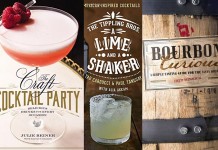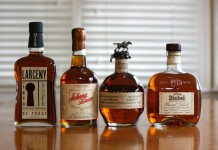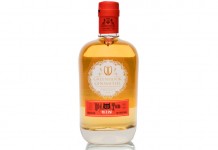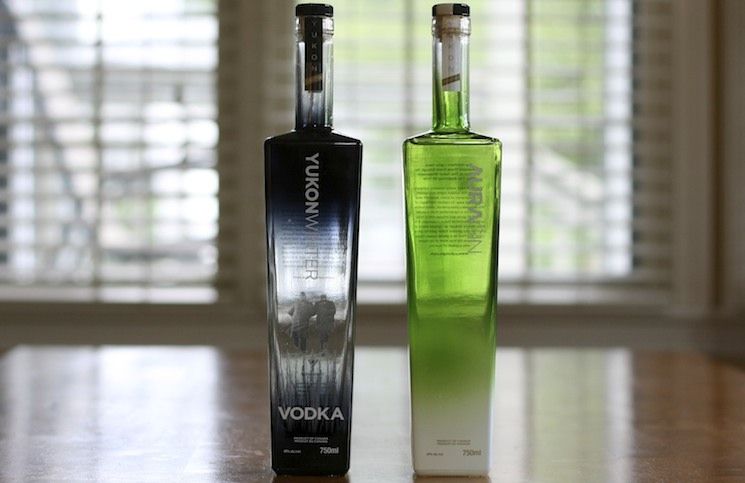
Up to just a few years ago, when someone referred to gin, they probably were referring to the the juniper-forward London Dry style of gin. For a very long time, this style of gin was gin. By definition, to be a gin (rather than a flavored vodka), a gin must have juniper as its dominant flavor note. In the London Dry style of gin, juniper is the star and the other botanicals in the mix (often including orris root, cassia bark, bitter orange, liquorice, angelica, and coriander) are dialed back as supporting characters. This style of gin works great when it’s paired with good tonic water, which is plentiful in Europe.
In the United States, tonic water is a much different animal. The FDA limits the level of quinine (the bittering agent in tonic) and US tonics often use high fructose corn syrup as a sweetener (rather than sugar in Europe). To make matters more complicated, because of high alcohol tax, many of the London Dry gins in Europe (especially the UK) are sold at a lower proof than in the US. When you pair a higher proof gin that has assertive juniper with subpar tonic water, you get a drink that has turned off generations of American drinkers to the gin category.
American Gin came about as an answer to this problem. Philadelphia Distilling’s Bluecoat Gin was one of the first craft gins on the market and was the spirit which kicked off a new breed of gin. This “American Style” gin was based on the idea that if you increase the intensity of the other botanicals in gin, you get a much more balanced and enjoyable spirit. This philosophy was codified by Bartender Ryan Magarian, who penned an influential piece, New Western Gin Defined, and helped launch Aviation Gin, a benchmark for this style.
The philosophy of “botanical democracy” expanded beyond US borders with notable gins like Hendricks and Nolets embracing non-traditional botanicals and balance with juniper. The gin market has exploded with so many great gins that we could have pages and pages of them on a best list. But since this gin revolution really had its roots in America, we thought we’d round up the Top 10 American Gins (including one from Canada).
#1 Leopold’s American Small Batch Gin (80 proof) – When it comes to botanical democracy, no gin embraces this philosophy with stronger zeel than Leopold’s. Most gins are made by steeping botanicals in neutral grain spirit and then distilling them. Alternatively, botanicals can be put in a botanical basket in a still so the alcohol vapors permeate them before condensing and becoming a liquid. Instead of distilling all the botanicals at once, which is how most gins are produced, the Leopold Bros. distill each botanical individually. This means the final gin is a careful blend of distilled botanicals assembled in a supremely complicated process. If that weren’t enough, the Leopold Bros. don’t use neutral spirits as the base for their gin; instead, they separately distill fermented wheat, potato, and barley into a blended base spirit. It’s a painstaking process but the result is nothing short of stunning. Leopold’s Gin is inviting from the start with a nose that exquisitely balances sweet orange, floral orris root, and piney juniper. There’s no edge to the nose, no bite, and the aromas come together to remind us of the smell you get from river rocks surrounded by pine trees. There’s an absolute elegance to the entry of Leopold’s Gin, the polar opposite of assertive but without sacrificing flavor. The entry is light and delicate with sweet orange and flowery orris. Juniper, cardamom, and coriander come in right behind the light and sweet notes in a symphony of spice. All of these elements come together in the midpalate which manages perfect balance. The spice begins to subside at the end of the midpalate and becomes more of a suggestion on the finish, which is mostly floral and citrus. Leopold’s American Small Batch Gin isn’t just one of the finest of the craft gins, it’s one of the best craft products on the market. (Leopold Bros., Denver, CO)
#2 Berkshire Mountain Distillers Greylock Gin (80 proof) – Although the distillery classifies the Greylock Gin as a London Dry style gin, it’s defined more by the integration of botanicals over the dominance of juniper. Juniper pine is clearly present on the nose, but it’s the lemon and orange notes that really jump out of the glass. Also, underneath the juniper is clear coriander and pepper spice that all come together for a deeply integrated and aromatic nose. The entry for Greylock Gin is nothing short of astounding – there’s nothing assertive or singular about this gin. Sweet citrus leads the pack as a top note with juniper following quickly behind, along with a bottom note of pepper and coriander. The way these flavors present is layered rather than sequential, creating immense complexity that you just don’t find in many gins. The mouthfeel is perfect and manages a balance between soft, fine, and light. The midpalate is a further exploration of flavor integration with all the flavors intensifying almost equally. The juniper and pepper spice peak but they are in lockstep with sweet citrus and an earthy undertone. The finish maintains all the flavors from the midpalate in a long and pleasant finish. Greylock Gin is easily sipped neat. Although the flavors are intense, the delivery of them is so elegant and well crafted that there isn’t even the suggestion of harshness. Greylock Gin is an amazing gin and is not only one of the best of the American Gins, it’s one of the best gins, period. (Berkshire Mountain Distillers, Great Barrington, MA)
#3 Schramm Gin (88 proof) – Although technically a “Canadian Gin”, Schramm Gin typifies some of the best of American Gin with a botanical mix that includes hops and rose hips. Schramm Gin has a true symphony of aromas in the nose including juniper, orange peel, coriander, and hops. All the astringent notes really stand out in the nose and come together excellently. The entry is full with a clear, starchy feel to the opening. As with the nose, the more astringent notes open things up with juniper, orange peel, and coriander. As it moves to the midpalate, the rosemary notes act as a transition to more of the warm notes, and as things open up we get more cinnamon, angelica, and hops. The undercurrent of the sweet elements from the potato base sneak in at the midpalate, almost as if it’s there to accompany the cinnamon. There’s a slight juniper kick towards the very end that leads to a long finish, with lingering rosemary and hops. Schramm Gin is one of the best sipping gins on the market and is superb neat or on the rocks (Pemberton Distillery, Pemberton, BC)
#4 Aviation Gin (84 proof) – From the moment you smell the nose of Aviation Gin, you know you’re in for something different. There’s definitely juniper and pine on the nose but it’s backed up with soft sweet orange, lush lavender, and earthy cardamom. The entry is soft and round, delivering a beautiful wide botanical medley of flavors. Juniper is there but cardamom is its equal companion. The spice notes in Aviation are multidimensional with caraway, anise, and just a hint of pepper there right behind the juniper and cardamom. Above all this is a nice light lavender floral note that ties very well with the more herbal tones. The combination of flavors is fantastic. The finish is soft and easy without much heat, with cardamom and lavender lingering on the palate. Unlike Leopold Bros. and Schramm gins, Aviation really shines best when mixed. Aviation Gin sings with citrus and honey in the Bees Knees and is a soul mate to Creme de Violette in the Aviation. Aviation Gin one of the gins that really helped codify the category for American Gin and it’s one of the best. (House Spirits Distillery, Portland, OR)
#5 Bluecoat American Dry Gin(94 proof) – Philadelphia Distilling deserves a lot of credit for helping revolutionize the gin category. It was their Bluecoat American Dry Gin that really helped solidify the new American style of gin. Unlike London Dry gins that lead with juniper on the nose, Bluecoat Gin leads with citrus including lemon, orange, and lime. Juniper is there, but it’s underneath the citrus blast and it’s accompanied by orris root and coriander. The entry is an explosion of flavor with strong citrus and juniper. The citrus here has a nice bittersweet quality which pairs well with the savory pine of the juniper at the same level of intensity. Other traditional gin botanicals are here as well, like coriander, but there seem to be some unconventional notes as well like chamomile. There’s also a grain note from the base spirit in the mix which adds a nice dimensionality. As with many other well-crafted gins, Bluecoat only intensifies in the midpalate and all the flavor notes come together. The finish is long with juniper, black pepper, and strong citrus lingering on the palate. Mixed, Bluecoat’s citrus notes intensify even more, making it a good choice for tonic as well as many of the citrus-forward gin cocktails like the Aviation. It’s also superb in a Bramble. (Philadelphia Distilling, Philadelphia, PA)
#6 Greenhook Ginsmiths American Dry Gin (94 proof) – Juniper naturally has a floral quality to it and Greenhook Ginsmiths American Dry Gin plays off of that quality by adding elderflower and chamomile to the mix. The nose of Greenhook is all about these flowers and leads with strong, sweet elderflower, and sandwiched underneath are juniper and cinnamon in equal parts. As you dig past these notes the chamomile begins to emerge. The entry is very floral with the elderflower and chamomile leading the charge. Juniper and cinnamon are right behind with spicy black pepper underneath. Everything intensifies in the midpalate with the spice ramping up to overtake the floral notes. The finish is nice and long with good spice and subtle floral undertone. Chamomile pops up in the botanical mix of a few gins, but elderflower isn’t as common. The sweet floral qualities of the elderflower really complement the spicier pine and black pepper notes from the juniper. The cinnamon is also a really nice complement on the spice side and it’s stronger here than with other gins we’ve tried. Chamomile seems to be the binding agent that bridges the gap between the sweet flower and spicy juniper, and pulls everything together. Greenhook Ginsmiths American Dry Gin is another great example of the new face of gin with a botanical mix that not only supports the juniper but explores the possibilities of mixing it with other compatible botanicals of the same intensity. (Greenhook Ginsmiths Brooklyn, NY).
#7 New Deal Portland Dry Gin, Recipe 33 – While many New American Gins use a blend of botanicals, Recipe 33 only uses juniper berries to get its flavor, a remarkable achievement considering the flavors it delivers. On the nose there’s a hint of honey with distinct lemon-lime notes paired with fresh evergreen. On the entry the gin expands to a wide flavor of sweet pine with citrus undertones and cool mint. The finish is quick but leaves your mouth very cool with a lingering subtle juniper flavor. Expertly distilled, Recipe 33 is a reductionist approach to classic gin done in a very modern way. It’s an excellent gin and ideal for people drawn to gin for the bright pine and evergreen flavors. (New Deal Distillery, Portland, OR)
#8 Voyager (84 Proof) – Voyager impressed us as an exceptionally solid gin and one of our top choices as an alternative to London Dry Gin in cocktails. Voyager’s nose has strong citrus notes like fresh lime, with pine, white pepper, lemon, eucalyptus, and cardamom. It has a lovely evergreen entry which is big and wide, more like pine needles than juniper. Voyager has a wonderful balance of sweet and savory with lemon notes, pepper, and cardamom supporting the pine. It has a medium finish that is a little peppery and then ends very lemony. Voyager isn’t as complex as Leopold’s or Aviation, but its bold entry and expansive taste make it an ideal gin for cocktails. (Pacific Distillery, Woodinville, WA)
#9 FEW Aged Gin (93 proof) – Aged gin isn’t anything new – there’s a long tradition of it, especially in Europe – but it’s been extremely uncommon in the United States. For their FEW Aged Gin, FEW Spirits looked to oak as a companion note to the juniper in their gin. FEW Aged Gin is dramatically different from their other gins, as it has a greatly stripped-down botanical mix to focus on the interaction between juniper and oak. The nose on FEW Aged Gin is so heavy oak, it would be easy at first smell to mistake this gin for a whiskey. Many of the traditional oak barrel notes lead on the nose including sawdust, oak spice, marzipan, and vanilla. Juniper is there but it’s a supporting note. Underneath it all are some fruity notes from the base spirit including crisp green apple. From the nose we feared that FEW Aged Gin was over-oaked but the entry reveals a true integration between oak and juniper. Deep oak spice mixes with juniper pine on a bed of vanilla and caramel. As with other American style gins, there are other flavors on par with the juniper, but here it’s oak, which provides an intense and alluring fusion of flavors. The spice is sandwiched between the sweeter notes from the barrel and the base spirit, creating a lovely complexity that draws us back again and again. The finish is medium long with spicy oak and juniper with an undertone of vanilla. FEW Aged Gin is very much a sipping gin but also does well in a Negroni or standing in for whiskey in a Manhattan.
#10 Dry Fly Gin – (80 proof) – A distinctly different style of gin, Dry Fly has thrown out the rule book and taken an entirely different approach to gin. The nose on Dry Fly Gin is huge green apple, strawberry, confectioner’s sugar, and honeysuckle flowers, and back – way, way back in the background – is just a hint of pine. The taste is apple, pepper, peach, vanilla, wheat, nectarine, and lime peel. The finish is pretty quick and leaves your mouth very cool and clean. We like Dry Fly’s Gin but it’s the kind of spirit which will get people arguing as to whether or not it’s actually a true gin. Either way, it’s an exciting entry into this space and an interesting New American Gin. (Dry Fly Distilling, Spokane, WA)
















